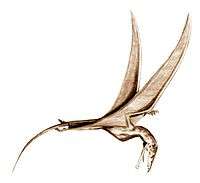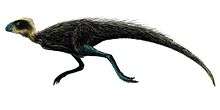Segisaurus
| Segisaurus Temporal range: Early Jurassic, 183 Ma | |
|---|---|
 | |
| Restoration of the holotype skeleton from 1936 | |
| Scientific classification | |
| Kingdom: | Animalia |
| Phylum: | Chordata |
| Class: | Reptilia |
| Clade: | Dinosauria |
| Order: | Saurischia |
| Suborder: | Theropoda |
| Family: | †Coelophysidae |
| Subfamily: | †Segisaurinae |
| Genus: | †Segisaurus |
| Type species | |
| †Segisaurus halli Camp, 1936 | |
Segisaurus (meaning "Segi canyon lizard") is a genus of small coelophysoid theropod dinosaur, that measured approximately 1 metre (3.3 feet) in length. The only known specimen was discovered in early Jurassic strata in Tsegi Canyon, Arizona, for which it was named. Segisaurus is the only dinosaur to have ever been excavated from the area.
Description

Segisaurus lived about 183 million years ago during the Jurassic period. Segisaurus was roughly the size of a goose and was a primitive bipedal theropod. Segisaurus was roughly 1 meter (3.3 feet) long, half a meter (1.65 feet) tall and weighed about 4-7 kilograms. It was nimble and insectivorous, although it may have scavenged meat also. It was bird-like in structure, with a flexible, elongated neck and stout body. Segisaurus was three-toed and had powerful legs that were long compared to its body length. Like its legs, Segisaurus had a long tail and long forearms. Its collar bone was not unlike a bird's, thus strengthening scientists' arguments that dinosaurs were related to avians. Segisaurus is described from the only specimen ever found, the holotype UCMP 32101, which was a sub-adult. The full size of Segisaurus as an adult may never be known. Strangely, clavicles were found on the Segisaurus specimen, which were unknown in other dinosaurs from that era. A speculative interpretation by Charles Lewis Camp was that the "splint-like" neck ribs supported a Draco-like patagium along the neck, to improve the animal's ability to move quickly.[1] Segisaurus is significant because it demonstrates that the clavicle was primitively present in early theropods.[2]
Classification
Segisaurus was described in 1936 by the paleontologist Charles Lewis Camp, based on specimen UCMP 32101, a fragmentary fossil skeleton which consisted of portions of the limbs, pelvis, and vertebrae. Cranial material was not recovered. Segisaurus went relatively ignored for the next half century. When the specimen was examined during this period, all who viewed it commented on the presence of clavicles and the apparently "solid" bones that the dinosaur had. Segisaurus appeared to be closely related to the better-known Coelophysis, but unlike the hollow bones of Coelophysis, Segisaurus had solid bones. This caused some scientists question whether Segisaurus was a theropod at all. In 2005, a re-examination of the Segisaurus holotype revealed that contrary to reports it did in fact have hollow bones. [3] In this study, Carano et al. found that although it was very unusual, Segisaurus was firmly a coelophysoid, and probably a close relative of Procompsognathus.[3]
Distinguishing anatomical features
A diagnosis is a statement of the anatomical features of an organism (or group) that collectively distinguish it from all other organisms. Some, but not all, of the features in a diagnosis are also autapomorphies. An autapomorphy is a distinctive anatomical feature that is unique to a given organism or group.
According to Rauhut (2003), Segisaurus can be distinguished based on the following features:[4]
- the dorsal centra are not very constricted ventrally
- the scapula is slender
- the humeral shaft has stronger torsion (~50 degrees) than does that of Coelophysis
- the presence of a large ischial fenestra (according to Carrano et al., 2005)[5]
- the humeral deltopectoral crest is rectangular
History of discovery

In 1933, Max Littlesalt, a Navajo Indian, discovered Segisaurus in Tsegi Canyon of the Navajo Sandstone Formation, of Coconino County, Arizona. The specimen was found in calcareous sandstone, which was deposited during the Pliensbachian - Toarcian stages of the Jurassic, approximately 190 to 174 million years ago. After discovering the remains, Littlesalt, who kept livestock inside the canyon, pointed out the fossils to archeologists who were on an expedition inside the canyon. Other than the first finding of Segisaurus, no other specimens have been discovered.
When the specimen of Segisaurus was discovered, Camp likened its posture to that of a "sitting hen", due to the position the dinosaur's remains were in.[1] Other theropods used this positions to sleep or stay sheltered during sand and ash storms.
Taphonomy
The Segisaurus holotype was found in a bed of sandstone, suggesting that the dinosaur had been buried in a layer of sand and died. This is still only a hypothesis, as no nest or den materials were discovered with the specimen. Geological features of the Navajo Sandstone Formation suggest that this genus lived in an environment resembling modern sand dunes.
References
- 1 2 Camp, C. (1936). "A new type of small bipedal dinosaur from the Navajo sandstone of Arizona." Univ. Calif. Publ., Bull. Dept. Geol. Sci., 24: 39-56.
- ↑ Chure, D. J., and Madsen, J. H., 1996, The furcula in Allosaurid Theropods and its implication for determining bird origins: Journal of Vertebrate Paleontology, v. 16, supplement to n. 3, Abstracts of Papers, Fifty-sixth Annual Meeting, Society of Vertebrate Paleontology, American Museum of Natural History, New York, New York, October 16-19, p. 28A.
- 1 2 Carrano, M.T, Hutchinson, J.R, and Sampson, S.D. (2005). "New information on Segisaurus halli, a small theropod dinosaur from the Early Jurassic of Arizona." Journal of Vertebrate Paleontology, 25(4): 835-849.
- ↑ Rauhut, O. W. M., 2003, The interrelationships and evolution of basal theropod dinosaurs: Special Papers in Paleontology, v. 69, p. 1-213.
- ↑ Carrano, M. T., Hutchinson, J. R., and Sampson, S. D., 2005 (published in 2006), New information on Segisaurus halli, a small theropod dinosaur from the Early Jurassic of Arizona: Journal of Vertebrate Paleontology, v. 25, n. 4, p. 835-849.



